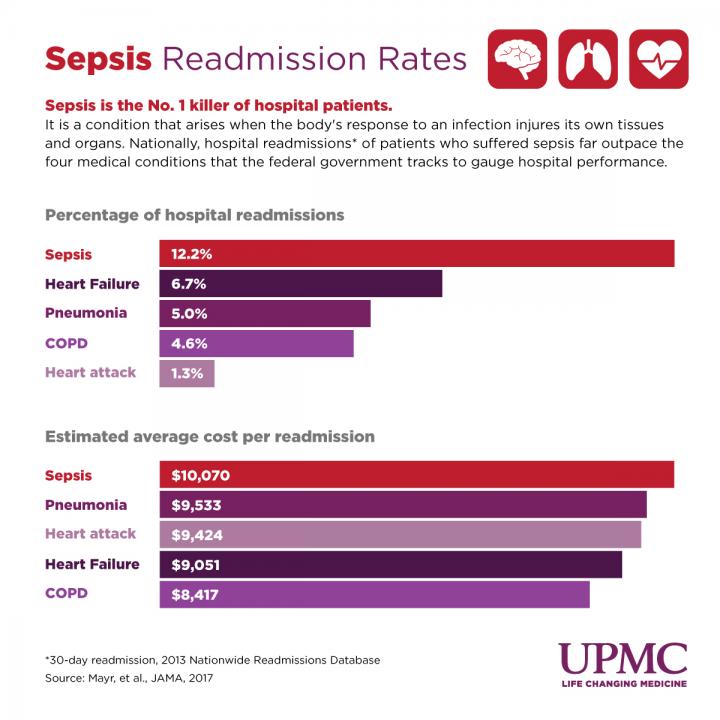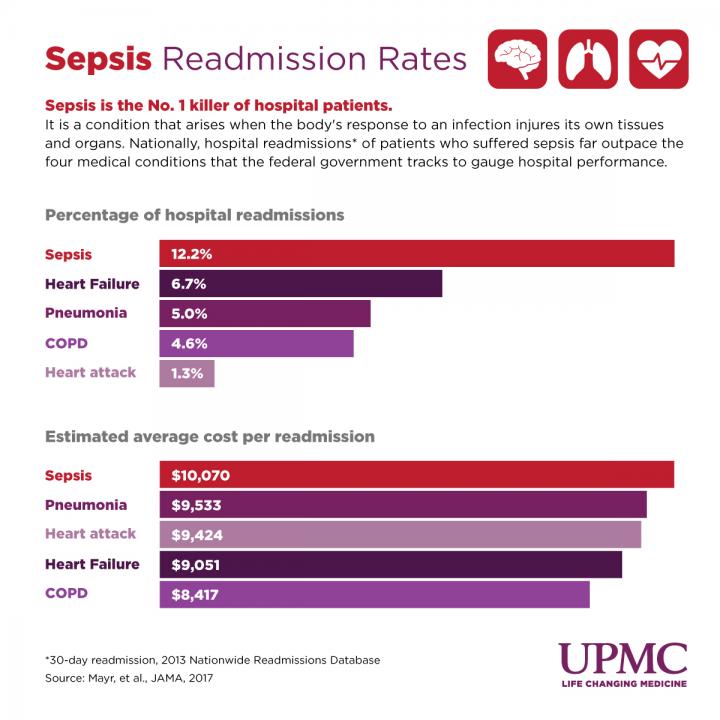
Credit: Nicole Davison/UPMC
PITTSBURGH, Jan. 22, 2017 – Sepsis accounts for considerably more hospital readmissions and associated costs than any of the four medical conditions tracked by the federal government to measure quality of care and guide pay-for-performance reimbursements, according to an analysis led by the University of Pittsburgh School of Medicine and VA Pittsburgh Healthcare System.
The findings, published today in the Journal of the American Medical Association, highlight the need for coordinated efforts to develop new medical interventions aimed at improving sepsis outcomes and reducing readmissions.
Sepsis is the No. 1 killer of hospital patients and was defined last year by an international panel as a condition that arises when the body's response to an infection injures its own tissues and organs, sometimes progressing to septic shock. According to the National Institutes of Health, it may occur in more than 1 million U.S. patients every year, and–despite best practice–an estimated 28 to 50 percent of these people do not survive.
"Many people think infections and sepsis are short-term illnesses and that once patients are discharged from the hospital, they are better," said senior author Sachin Yende, M.D., M.S., associate professor in the Pitt School of Medicine's departments of Critical Care Medicine and Clinical and Translational Sciences and vice president of Critical Care at the VA Pittsburgh. "But all research to date shows that sepsis has serious, lingering consequences, and patients continue to have problems well after they are discharged."
The Centers for Medicare & Medicaid Services currently tracks readmissions for four medical conditions: heart attack, heart failure, chronic obstructive pulmonary disease (COPD) and pneumonia. A key component of the Affordable Care Act, the Hospital Readmission Reduction Program, penalizes hospitals if they have excessive rates of readmissions for these conditions.
Yende and his team analyzed data from the 2013 Nationwide Readmissions Database, which comprises 49 percent of U.S. inpatients, for the four conditions and sepsis. They revealed that sepsis accounts for 12.2 percent of readmissions, followed by 6.7 percent for heart failure, 5 percent for pneumonia, 4.6 percent for COPD and 1.3 percent for heart attack.
Sepsis also costs more. The estimated average cost per readmission for sepsis was $10,070, compared to $9,533 for pneumonia, $9,424 for heart attack, $9,051 for heart failure and $8,417 for COPD.
"This really puts in perspective how important sepsis is," said lead author Florian B. Mayr, M.D., M.P.H., faculty member in Pitt's Department of Critical Care Medicine and the Center for Health Equity Research and Promotion at the VA Pittsburgh. "If we, as a nation, place such high emphasis on reducing readmissions for the other four conditions, then we really need to look for opportunities to improve outcomes for sepsis, which has a higher rate of readmission than heart failure. People who survive an initial episode of sepsis often don't do well. They return to the hospital frequently, accrue new health conditions and have significantly elevated death rates."
###
Additional authors on this research are Victor B. Talisa, M.S., and Chung-Chou H. Chang, Ph.D., both of Pitt's Graduate School of Public Health; Vikram Balakumar, M.D., of Pitt's Clinical Research, Investigation, and Systems Modeling of Acute Illness Center; and Michael Fine, M.D., M.S., of the VA Pittsburgh.
This research was supported by National Institute of General Medical Sciences grants R01GM097471 and R34GM107650.
About the University of Pittsburgh School of Medicine
As one of the nation's leading academic centers for biomedical research, the University of Pittsburgh School of Medicine integrates advanced technology with basic science across a broad range of disciplines in a continuous quest to harness the power of new knowledge and improve the human condition. Driven mainly by the School of Medicine and its affiliates, Pitt has ranked among the top 10 recipients of funding from the National Institutes of Health since 1998. In rankings recently released by the National Science Foundation, Pitt ranked fifth among all American universities in total federal science and engineering research and development support.
Likewise, the School of Medicine is equally committed to advancing the quality and strength of its medical and graduate education programs, for which it is recognized as an innovative leader, and to training highly skilled, compassionate clinicians and creative scientists well-equipped to engage in world-class research. The School of Medicine is the academic partner of UPMC, which has collaborated with the University to raise the standard of medical excellence in Pittsburgh and to position health care as a driving force behind the region's economy. For more information about the School of Medicine, see http://www.medschool.pitt.edu.
About VA Pittsburgh Healthcare System
VA Pittsburgh Healthcare System is one of the largest and most progressive VA medical centers in the country, serving Veterans throughout the tristate area of Pennsylvania, Ohio and West Virginia. The health care system's University Drive campus offers acute care and operates 146 beds distributed among medicine, surgery, neurology and critical care, as well as 78 inpatient psychiatric health beds. The system's H.J. Heinz III campus is home to a 225-bed community living center, a 100-bed Veterans Recovery Center and an outpatient-based Ambulatory Care Center. VA Pittsburgh also supports five Community Based Outpatient Clinics located in Western Pennsylvania and Eastern Ohio. In 2016, VA Pittsburgh served more than 70,000 unique patients through more than 718,000 outpatient visits and nearly 13,000 admissions. More than 30 percent of VA Pittsburgh's 3,700 employees are Veterans. For more information, visit http://www.pittsburgh.va.gov.
VA Pittsburgh executed more than $30 million in research projects in 2016, benefiting VA and non-VA health care consumers. Studies by VA Pittsburgh researchers have led to recent innovations in mobility, treatment for hepatitis C, and understanding racial disparities in health care delivery. Specialized VA Pittsburgh national research programs include four centers of excellence in health equity, geriatrics, human engineering and mental illness.
http://www.upmc.com/media
Contact: Allison Hydzik, University of Pittsburgh Health Sciences
Office: 412-647-9975
Mobile: 412-559-2431
E-mail: [email protected]
Contact: Kathleen Pomorski, VA Pittsburgh Healthcare System
Office: 412-822-3578; 412-360-3065
Mobile: 412-216-8890
E-mail: [email protected]
Media Contact
Allison Hydzik
[email protected]
412-647-9975
@UPMCnews
http://www.upmc.com/Pages/default.aspx





